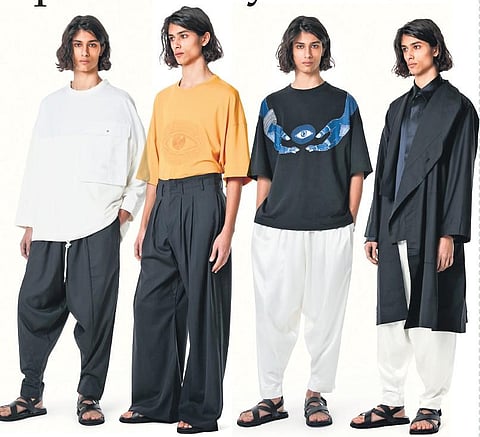

A traditional Tamil kolam, and a new-age streetwear brand. Never the twain shall meet, right? Wrong. For that’s exactly what’s happened in No Grey Area’s (NGA) recent collection, Pravah. The brand has always drawn inspiration from ancient Indian garments and their geometrics to create unique contemporary interpretations. The new range does just that by not only reinventing kolams, but also reinterpreting sari drapes and traditional kurta necklines in modern silhouettes like jackets, wrap shirts, trousers and tops.
The collection, which debuted at Paris Fashion Week before launching in India earlier this month, uses organic materials like 100 per cent wool, silk and cotton as primary fabrics. “Pravah showcases Indian heritage and the natural colours of indigo, pasi green and saffron, adorned with traditional hand embroidery and handloom techniques to create a gender-inclusive range,” says NGA founder Arnav Malhotra. Paris Fashion Week, he adds, “raised the bar with everything, from rethinking the clothes, the concept behind the brand, and how we communicate the story to customers through our imagery”.
Picking his favourite from the range that comprises 43 designs, Malhotra says it has to be the kurta wrap jacket. “We’re doing one version in traditional Indian silk with all-over hand embroidery and another version in an Italian wool suiting fabric,” he says. The garment is zero-waste (no piece of the fabric was wasted while cutting and sewing the garment). It is also gender-inclusive and can be styled or worn in different ways.
“The piece is a hybrid between the ancient kalidar kurta and a Western wrap jacket. It embodies everything I want the brand to be. We draw inspiration from different periods in Indian history and mythology and look for concepts that are still of value in modern-day India,” he adds.
No Grey Area was born in 2019 with the thought that Indian garments are often represented through couture, ethnic and occasion wear, but lack daily functionality and reusability. The brand tries to fill that gap by encompassing heritage and modernity in its collections. “This can be seen in silhouettes like the Indian Directional Bomber, where the main fabric is an ikat sari. It is a light silk with resist-dyed yarns woven into the warp and weft,” says the designer, who shuttles between Chennai and London.
The 29-year-old says he initially never imagined working in fashion, but discovered a passion for the craft while working for a tech startup in New York. The platform powered the backend for several modelling and creative agencies there. Through fashion weeks, shows, parties and more, he found himself drawn to the liberation and self-expression in the space. “This inspired me to create something of my own,” he says.
But combining Indian silhouettes with Western archetypes to come up with something unique was the biggest challenge. “It’s like creating a new language while blending the semantics, syntax and morphology of what came before,” says Malhotra, who looks up to Chitose Abe, the founder and designer of the Japanese brand, Sacai. She is recognised for her innovative designs, merging different materials and patterns to create hybrid garments.
“Fashion today has transcended the niche and has gone mainstream, influencing pop culture. With many brands pushing to sell directly to consumers, especially post-Covid, influencers and social media play
a crucial role in how products are promoted and sold,” says the designer, who believes social media today is a democratised platform that allows younger brands an even playing field to create something disruptive to gain traction over more established brands. “It also helps fashion brands build their identity and foster a sense of community among their followers as well,” he adds.
What next? “I would like the world to celebrate the fluidity of Indian designs, perceiving them as functional, sustainable garments that have their place in urban cities. We want to explore ancient India through a contemporary lens,” he says.